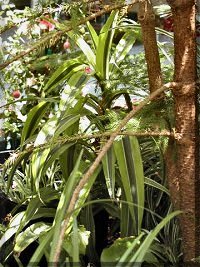
Zea mays

Zea mays
Description - There are four wild species in the genus Zea, all of which are native to Mexico and northern Central America. One of these, Zea mexicana, commonly called teosinte, gave rise to maize (Zea mays). Genetic evidence suggests that maize originated mainly from the Balsas race of teosinte which is found in the Balsas River basin in the Michoacan-Guerrero border region of western Mexico. Zea mays is thought to have speciated from Z. mexicana into a separate gene pool many thousands of years ago afterwhich it diversified into a number of different races.
Zea mays is similar to teosinte in that it is a quick growing annual with C4-type photosynthesis, giving it the ability to grow well in bright sunlight with limited water, and it has unisexual inflorescences: the tassel (male) and the ear (female). Zea mays – which is thought to have origin:ated in Mexico and was eaten historically throughout much of North America – became the center of art and religious life for many tribes. Numerous ceremonies and rituals were performed for corn, and by the time the Europeans arrived, various tribes referred to maize by words that mean "our life" or "it sustains us" or "giver of life."
Medicinal uses - Zea mays was used medicinally in several ways. Tthe Chickasaw tribe of North America squeezed the oil from the grains and rubbed it directly into the scalp as a dandruff remedy. Some Native American tribes in the eastern part of the continent used the oil in poultices for boils, burns, and inflammations. Corn meal has also been used as an emollient for skin problems. Corn starch is an effective antidote for iodine poisoning. Corn provided starch, syrup, molasses, mush, meal, flakes, oil, and corn on the cob. Recent scientific evidence shows the stimulation of interferon and macrophage migration attributable to corn. Corn has exhibited cholesterol-lowering, kidney stone-dissolving, and other positive qualities. The silk and oil both have medicinal properties. Corn exhibited hypocholesterolemic activity, and has also been found to contribute to the dissolution of kidney stones in adult humans. An estrogenic and ovulation induction effect was observed in animal studies. Preliminary animal experiments with an aqueous extract have found immunostimulant activity, as well as the stimulation of interferon induction and macrophage migration.